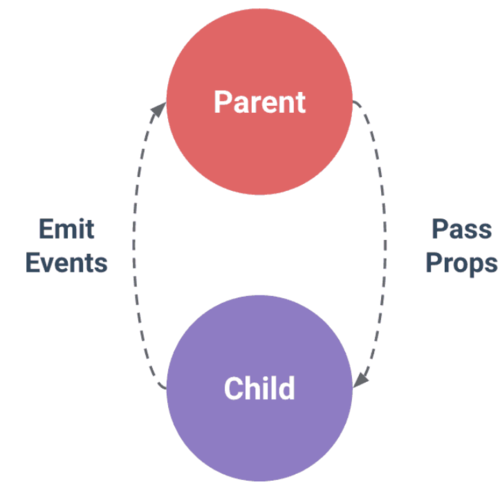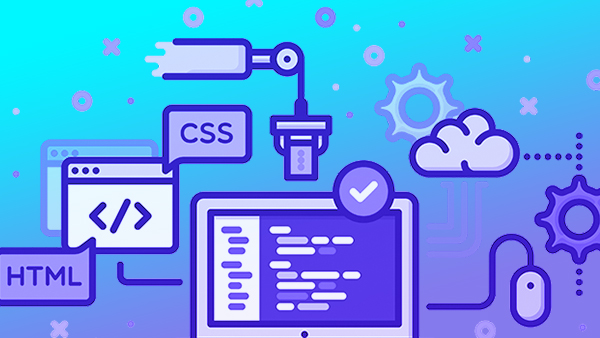Vue组件一-父组件传值给子组件
开始
Vue组件是学习Vue框架最比较难的部分,而这部分难点我认为可以分为三个部分学习,即
所以将用三篇博客分别进行介绍以上三种情况和使用
Vue的设计者对组件的理解
Vue的设计者,对组件和父组件之间的关系流上做了阐述,即单向数据流图:父组件向子组件传递数据,子组件回馈事件
组件意味着协同工作,通常父子组件会是这样的关系:组件 A 在它的模板中使用了组件 B。它们之间必然需要相互通信:父组件要给子组件传递数据,子组件需要将它内部发生的事情告知给父组件。然而,在一个良好定义的接口中尽可能将父子组件解耦是很重要的。这保证了每个组件可以在相对隔离的环境中书写和理解,也大幅提高了组件的可维护性和可重用性。
在 Vue 中,父子组件的关系可以总结为 props down, events up。父组件通过 props 向下传递数据给子组件,子组件通过 events 给父组件发送消息。看看它们是怎么工作的。

属性下传,事件上传
父组件挂载的实例
上文提到的三篇文章,都使用一个父组件挂载对象,内容比较长(可以选择不看,直接看props的使用),感兴趣可以到git上去看源代码
模版:
<body> <div id="el-component-id"></div><body
Vue实例:
var vm = new Vue({ el: "#el-component-id", data: { welcome: "welcome to Vue", parentMessage: "this is parent message", iMessage: "", person: { name: "小明", from: "江苏", to: "江西", purpose: "喝一杯牛奶"
}, persons: 10, sumOfTotal: 0, nativeSumOfTotal: 0, food: "牛肉", languages: ["英语", "中文", "希腊语", "法语", "俄罗斯语"], dynamicComponent: "AppHeader"
}, methods: { incrementWithTotal: function() { this.sumOfTotal = this.sumOfTotal + 1;
}, nativeDoThing: function() { this.nativeSumOfTotal += 1;
}, changeCurrentComponent: function() { let components = ["AppHeader", "AppFooter", "AppMain"]; let idx = components.indexOf(this.dynamicComponent); if (idx == 2 || idx == -1) {
idx = 0;
} else {
++idx;
} this.dynamicComponent = components[idx];
}
}, components: { AppHeader: { props: ["initialText"], template: "<div><strong>{{title}}</strong></div>", data: function() { return { title: this.initialText
}
}
}, AppFooter: { props: ["initialText"], template: "<div><sub>{{footerTitle}}</sub></div>", data: function() { return { footerTitle: this.initialText
}
}
}, AppMain: { props: ["initialText"], template: "<div style='color:blue;'>{{mainContent}}</div>", data: function() { return { mainContent: this.initialText
}
}
}
}
});1. props传递单个参数
组件定义:
// 使用props数组的形式进行传递参数Vue.component("component-span-child-1", {
props: ["message"], template: "<span>{{message}}</span>"})模版中进行传值:
<div> <h4>组件一-props传递单个参数</h4> // 字面量传值 <component-span-child-1 message="component-style-one"></component-span-child-1> <br /> // 绑定父组件对象实例属性 v-bind:someProperty简写为:someProperty <component-span-child-1 :message="parentMessage"></component-span-child-1> <br /> <component-span-child-1 v-bind:message="parentMessage"></component-span-child-1> <br /> <input v-model="iMessage" placeholder="请输入值"/> <component-span-child-1 :message="iMessage"></component-span-child-1></div>
2. props传递多个参数
组件定义:
Vue.component("component-span-child-2", { props: ["name", "from", "to", "purpose"],
template: "<div><span>{{name}}从{{from}}到{{to}},{{purpose}}</span></div>"})模版中传值:
<div> <h4>组件二-props传递多个参数</h4> // 字面量传值 <component-span-child-2 name="小李" from="南京" to="北京" purpose="去买个书包"></component-span-child-2> // 父组件实例对象属性传值 <component-span-child-2 :name="person.name" :from="person.from" :to="person.to" :purpose="person.purpose"></component-span-child-2></div>
3. 使用props对象高级传参,并对参数进行校验
组件定义:
可以校验传递进来的属性,例如:1. 校验类型 2. 是否必须传递 3. 提供默认值 4. 通过函数校验,如校验Number类型是否大于某个值
Vue.component("component-span-child-3", { props: { name: { type: String, require: true
}, persons: { type: Number, default: 1, validator: function(value) { return value > 0;
}
}, location: { type: String, default: "上海"
}, action: { type: String, default: "拉粑粑"
}
}, template: "<div><span>{{name}}和{{persons}}个人,去{{location}}里面{{action}}</span></div>"})模版中使用:
<div> <h4>组件三-使用props对象传递参数,和校验</h4> <component-span-child-3 name="小狗" :persons="persons" location="讲述郾城" action="去淘金啊"></component-span-child-3></div>
总结
父组件向子组件主要是通过props关键字,主要使用情况可以分为上面描述的三种。props的封装可以是一个数组,也可以是对象。
当使用数组封装props的时候,只是简单将父组件的参数传递给子组件使用,此处的参数可以是对象,字符串,number类型的数据
当使用对象封装props的时候,可以更加高级的校验参数,比如参数类型,默认值,参数大小等一系列校验。当不符合时候,可以看到Vue再控制台给出错误警告
熟练掌握父组件向子组件传递参数的方法,可以对Vue的关键部分更快的理解。
作者:mdiep
链接:https://www.jianshu.com/p/7e825cd5f086

 随时随地看视频
随时随地看视频




